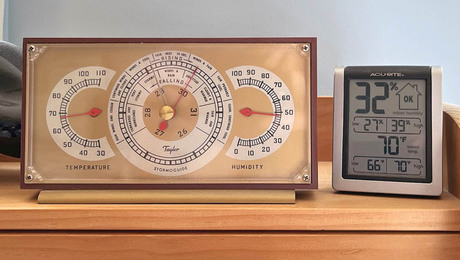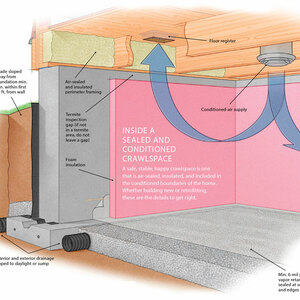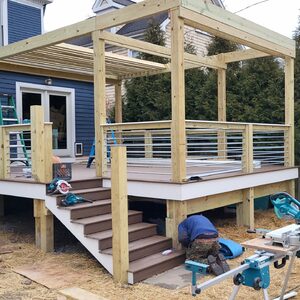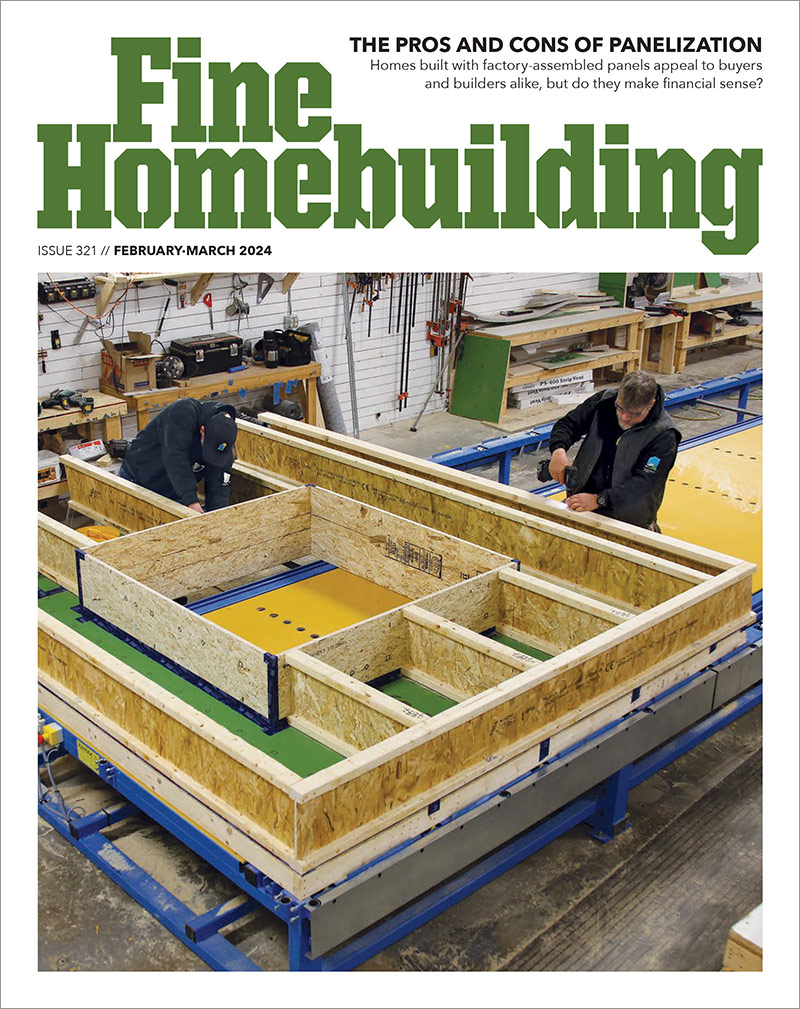any suggestions on pouring a few inches of concrete on top of our garage slab, originally done in the 30’s? we plan to enclose the garage for studio space, and live in a hot wet climate (Houston). It gets a bit of water when it rains hard here, so that is why we are considering pouring a slab on a slab. any suggestions welcome.
Discussion Forum
Discussion Forum
Up Next
Video Shorts
Featured Story

Source control, ventilation, and filtration are the keys to healthy indoor air quality. Dehumidification is important too.
Featured Video
How to Install Cable Rail Around Wood-Post CornersHighlights
"I have learned so much thanks to the searchable articles on the FHB website. I can confidently say that I expect to be a life-long subscriber." - M.K.

















Replies
Are you trying to even out the slab, or trying to level it? How high over the current surface do you want it to be?
Tu stultus es
Rebuilding my home in Cypress, CA
Also a CRX fanatic!
Look, just send me to my drawer. This whole talking-to-you thing is like double punishment.
we want to raise it enough to keep the water out, maybe 3 inches?
Where is the water coming from? How will a new slab topping stop it?
there is a large tree root running along the front of the garage, and water runs around it and comes in there. we will be taking the garrge door out and making a solid wall there, but want to make sure the slab stays dry by raising the slab that is on grade. ideas?
Water may still migrate in to some degree between the slabs.
Consider trenching along the front of the garage and installing a french drain to move the water along, removing the tree or regrading the entire perimeter.
Lacking specific info about your situation there maybe many things more effective and affordible.
Just A Guy With A Hammer
removing our tree is not an option, but I am curious why a slab on a slab is not a good option..?
Not a problem. I've done it several times for different reasons. My thought was there may be cheaper alternatives.
I suppose after you pour this if you flash your wall well you'll be fine.
I once poured a fibered concrete leveling mix over a large 30x40 garage area. The pour varied from 1 1/2" to just over 4" in places. The old slab was cracked up badly from a long gone huge elm tree. We painted a 2' wide blue bonding agent around the perimeter and layed 15# felt over the remaining slab to allow for movement.
This was something my concrete company suggested I try for S&Grins. They payed for the product. Two years later there was still no failure. The slab looked great. I doubt it now but it's been 15 years.
I guess my point is you have less to no real risk of failure,so I'd try it.
Just A Guy With A Hammer
I've done it several times without any problems.
How thick is the slab, and how badly broken?
Many garage slabs of that era are only 3" thick or so, and anything you poured over the top would be quickly broken up. It may be better to tear it out and replace it.
It is not broken at all, our problem is that water seeps in around a large root at the garage door (we will be replacing the door with a solid wall). the floor is at grade, we are thinking of raising to prevent water from coming in.
Is there a foundation around most of it that's higher, or is the structure sitting right on the slab?
God is REAL, unless explicitly declared INTEGER
it is right on the slab
And the bottom plate (and bottom of the studs) isn't rotten??
God is REAL, unless explicitly declared INTEGER
not that we can see. the water would seep in the middle of the garage and it never got to the walls. it only started flooding when they built the big honking house next door to us 3 years ago.
How close is the slab to ground level on the sides and back?
God is REAL, unless explicitly declared INTEGER
at grade, but there is no water backup in those areas.
Jab an ice pick into the bottom plate a few places.
God is REAL, unless explicitly declared INTEGER
I would try to drain this water away from your building somehow, even if just by cutting a shallow ditch on the surface.
do you mean instead of pouring a new floor?
I mean no matter what... divert the water away from your building.
gotcha, thanks for your response.
the new slab will crack just like the old one.
there are no cracks, we are just raising it above grade because water comes in the garage door.
Well, it sounds like all that is really needed is a curb for the new wall across the garage door opening.
I'd recommend using PT sleepers and using a wood floor to bring this up to the existing house floor elevation. The wood floor will make for a better studio floor in some ways, not least of which will be from not swinging through the temperature swings Houston can see.
It also avoids the fun of a giant cold joint between th old nad new work, which can be exciting with some of the soils in the metro Houston area (especially when it varies so much from the Ship Channel over to Katy and from Montgomery down to La Marque and the sea).
What sort of foundation is under the existing house? How much elevation change into the garage?
what are pt sleepers? our house is pier and beam, about 15 feet away from the garage, which is on grade. we did alot of french drain work around the patio and in the yard parallel to the garage, so drainage has been pretty good. there is the one large tree root that runs along the door of the garage, and water seeps around that into the garage. that is the only place we have water coming in.
what if the berm does not work and we end up with water underneath the wood floor?
what are pt sleepers?
Sorry, slipped into strade-speak. PT in this case means Pressure Treated, where chemicals are forced, under pressure, into lumber to saturate them, which gives them resistance to problems related to moisture and insect damage.
Sleeper is a term-of-art refering to lumber laid on a horizontal surface (it is laying down, like it was "sleeping" on the surface) to provide a joist-like point to nail sub flooring upon.
about 15 feet away from the garage, which is on grade
Ah, ok. With an attached garage, often the desire is to have one floor level, which then "drives" the flooring design.
Stand-alone garage now generates new design considerations.
what if the berm does not work and we end up with water underneath the wood floor?
Well, the same problems if water gets under a new concrete slab. despite perceptions to the contrary, concrete is not inherently waterproof. In fact, it's rather porous to liquid water, unless specifically designed for water-tightness.
Now, what would be very nice would be that your on-grade garage has a curb cast in its slab supporting the existing walls. This would make a known elevation to match, for one. The former garage door sill could then be saw-cut, allowing the installation of a flexible sealing strip ("dogbone" being a term-of-art for the double-bulb cross-section) which then has the new curb cast over it.
Now, if your garage slab does not have a curb on it (and many of that era in Harris County do not), then there are other issues. One of which would be that you'd only have the wooden walls to pour a slab against--and concrete against wood is a no-no most places, as double no-no around Houston's maritime humidity and rain. (Not that here in Brazos Co, it's any drier, generally.)
Now, there's another consideration since the garage is at grade. We want to be careful making steps, as we don't want to create trip hazards.
For the tree root, you might want to consult an arborist (tree surgeon) to see about getting it trimmed. If it is visibly against either or both the garage & driveway slabs, neither condition is generally good. Tree roots move slow, but inexorably. They will break concrete. Will not do any of us any good to get you this new space for the tree root to break the garage slab by tension in some hiddne place.Occupational hazard of my occupation not being around (sorry Bubba)
I think you have convinced me against a slab on slab. But what IF water gets underneath the floor on the pt sleepers? (thanks for the new term!) is there a way to make the pt berm impenetrable?
But what IF water gets underneath the floor on the pt sleepers?
Well, they are resistant to problems with moisture, that's why they are treated. The only issue at that point is getting the putative moisture out.
Sleepers are typically installed edge up, so there's little area in contact with the slab. Many professionals will also install a barrier between the actual lumber and the slab to further protect the wood from any moisture.
So, this wooden construction is built from the "ground" (slab in your case) up to resist moisture.
is there a way to make the pt berm impenetrable?
Not anymore impenetrable than the existing walls' bottom plate, really.
Point of terminology, "berm" is an embankment of soil or earth; "curb" is a cast or coursed step or lip. Ideally, your garage slab ought to have a cast-in-place curb about 4"x 4" around its edges upon which the walls are set (this allows for the 6-8" grade seperation often required to help prevent water damage or insect infestation).
You may need to make some exploratory investigations to see how the garage wall was built. Middling easy if the inside wall is sheetrock, harder if clad in plywood or plaster or the like, but a discrete spot near where the deomlition work is to happen can be illuminating.Occupational hazard of my occupation not being around (sorry Bubba)
is there a way to make the pt berm impenetrable?
Actually, you might consider a narrow stem wall along the garage face under the frame wall, out of either concrete or concrete blocks. If part of this wall could extend down in front of the slab it might make a better barrier.
Assuming that the water will find any direction easier to follow than migrating into the garage, this might keep it dry and mildew free as well.
Just A Guy With A Hammer
Edited 1/14/2009 3:10 pm by jagwah
If te "lower" slab is getting wet, moisture would wick up through the upper slab.
If there's a root growing under the slab - there's a good chance it wall cause both slabs to heave.
Maybe check with a tree person to find out if that root can be cut out?
And, if the sill plate is not treated lumber, be sure the new slab isn't poured to be in contact with the existing sill plate - unless you like to repair rot and/or treat for termites!
"Ask not what the world needs. Ask what makes you come alive... then go do it. Because what the world needs is people who have come alive."
Howard Thurman
thanks for the response, I think we will NOT pour a slab on the perfectly good slab, but instead put some sleepers on the old slab and build a plywood floor. too many possible problems with the slab on slab. the tree and root must stay, the tree guy has been out to look. it runs parallel with the slab.
Penny, This is what I gathered from the thread.
You've got an intact slab-on-grade foundation in your garage. Water gathers in the middle of your garage but the sills for your walls don't seem to be affected by moisture. Little can be done externally to control water flow around the garage area.
I, and others who have posted here have had good luck placing concrete on top of a structurally sound slab. Mine also was fiber reinforced. However, installation of a 2nd slab may just move the water to a place where it may do even more damage like the sills. If water is only gathering in the middle of the slab you may want to consider installing a drain there and running it to daylight, sewer, or storm drain.
Edited 2/9/2009 10:21 pm ET by semipro